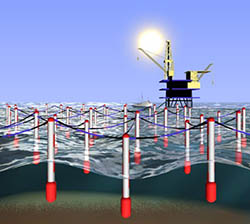How We Can Use Energy from Waves, Tides and Currents? – Updated Article With Extra Information
Oct 19
Additional resource information is available for tide and current power?
Tidal wave generatorsTidal power compared to other sources of energy
Tidal power - the new source of hydroenergy
Tidal wave energy- the new cutting edge technologies
Tidal power- natures renewable hydroelectric energy
Top 5 wave energy advantages

Energy from tides is perhaps the most promising of all the ocean alternative energy sources, as tides are completely regular and predictable. Energy from tides is generated in areas of high tidal movement, where the difference between the low and high tide is at least 4.8 meters. An enormous amount of electricity can be generated in this way in places such as the Bay of Fundy, which has one of the largest tidal ranges in the world (over 15 meters). This means that over 100 billion tons of water flow in and out of the bay each day.
Energy from tides is generated by building a barrage, through which water flows which is moving due to the effect of the tide. This water then runs turbines, which in turn generate electricity. Tidal energy can also be tapped into by using the tidal currents which are 20 to 30 meters below the surface. In this case, underwater turbines are used like those that you can see on wind farms, but adapted for underwater use. The rotors can be up to 20 meters in diameter. Such rotors, which generate energy from currents, are favored by many above barrages as they have less of an environmental impact.
Ocean wave energy has enormous potential simply due to the large number of locations where this energy could be harnessed. Wave energy generation is, however, more problematic than tidal energy generation because waves are unpredictable and the technology installed has to be able to cope with all possible wave sizes, including those that occur in severe storms. The most common type of wave power machine is an oscillating water column, which is located just below the surface of the sea. It rises and falls, which in turn compresses and depresses an air column attached to it, the moving air which result then powers a turbine.
Researchers developing alternative energy technologies that are connected with the sea have a specific set of problems to deal with – the sea is a very harsh environment and it is naturally corrosive to many elements. Scientists are busy as we speak finding ways to overcome these challenges, and harness the limitless power of the ocean. One way or another, if its not ocean based alternative energy that ultimately takes over fossil fuels, one or more of the alternative energy sources will get there some time in the not too distant future, be it solar, wind power, or whatever else: the world is relying on it.
For more information on alternative energy, go to:
en.wikipedia.org/wiki/Alternative_energy,
en.wikipedia.org/wiki/Renewable_energy
Related Posts
- Japan’s Commitment to Smart-Communities Using Wind Power
- Geothermal Energy Investment – the Risks and Uncertainties for the Budding Investor – Part 2.
- Ocean Thermal Energy: Pros and Cons - Updated Article With Extra Information
- The Science of Saltwater Cloud Making: can it Help Drought Areas?
- Municipal solid waste management: trash to biomass treasure
5 Responses to “How We Can Use Energy from Waves, Tides and Currents? – Updated Article With Extra Information”
Leave a Reply
You must be logged in to post a comment.





The problem with tidal barrages of-course is that they have a large local environmental impact. Its ironic that many environmentalists are against tidal barrages! For instance, green parties lobbied against the Severn barrage scheme in the UK, and they won. In this case, it would have destroyed about 50% of habitat in the estuary, and possibly would have led to salmon extinction in the estuary.
Personally I think that the environmental concern are nothing compared to the enormous benefit of such a scheme – if it had gone ahead it would have supplied about 5% of the UK’s needs!
October 27th, 2010 at 2:52 pmI have read that out of all the ocean technologies, tidal is the most mature. It promises to provide predictable, low-cost electricity, and a standard design has been developed.
October 27th, 2010 at 2:47 pmThe UK is currently the world’s leader for tidal and wave energy. more than 300MW of projects are set to be implemented over the next 5 years. This is despite of the recent set back – the cancellation of the Severn Estuary tidal scheme.
The UK government aims to add 1.3GW to the grid by 2020 through tidal and wave power. This is been driven by the requiremnts to produce at least 15% of power from renewables by 2020.
Other key markets are Ireland, France, Portugal, and Australia. It is in these countries that the industry will be focusing on in the next decade.
October 27th, 2010 at 2:45 pmThe global ocean energy sector is really taking off. Only a dozen projects were implemented last year, but there are more than 45 wave and tidal projects which will be tested in 2010 and 2011.
October 27th, 2010 at 2:42 pmThe ocean’s are a great source of untapped, unharnessed energy. To be able to use them as an energy source would definitely be one way to help stop things such as strip mining around the world.
January 19th, 2009 at 12:33 am